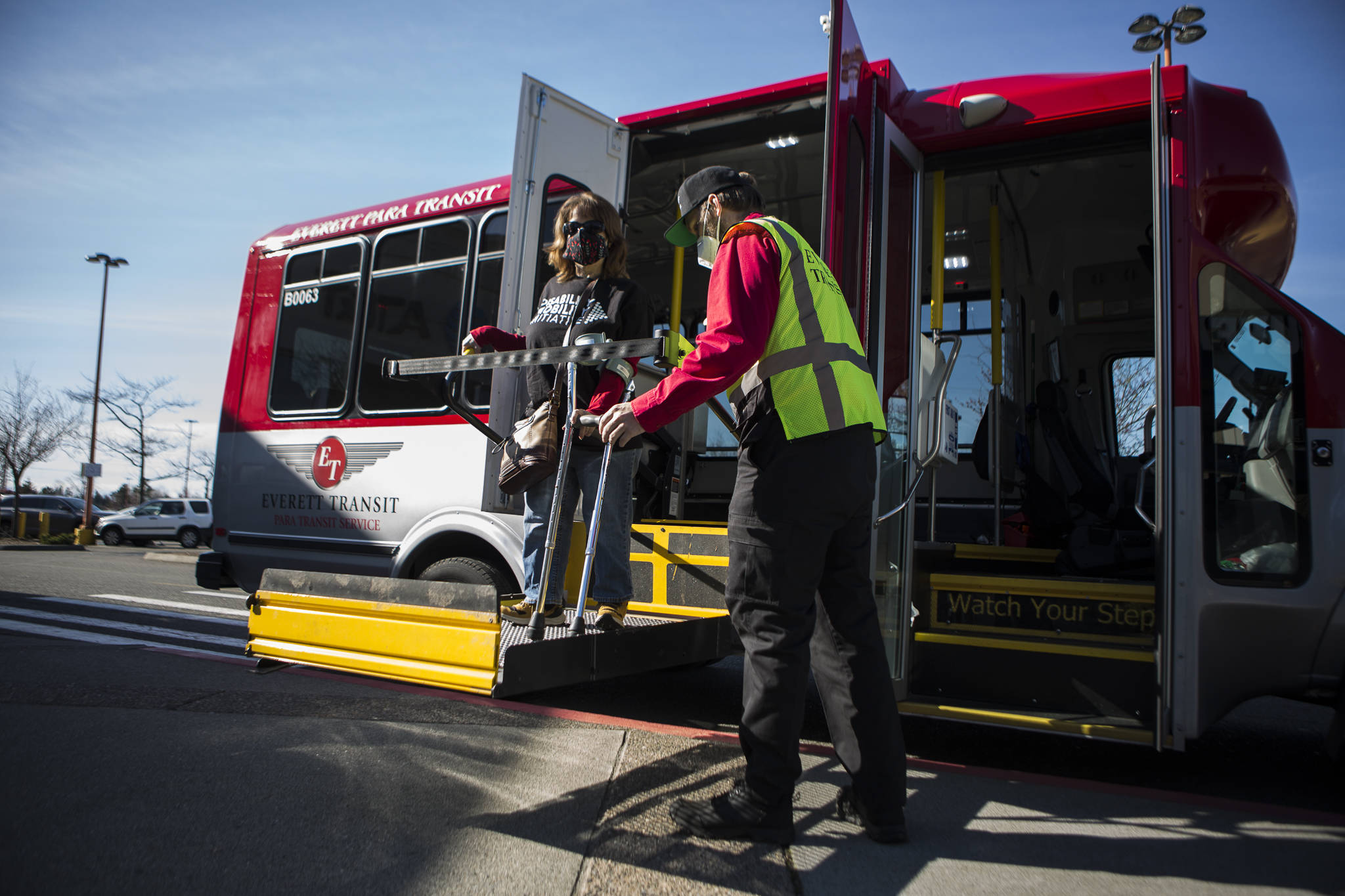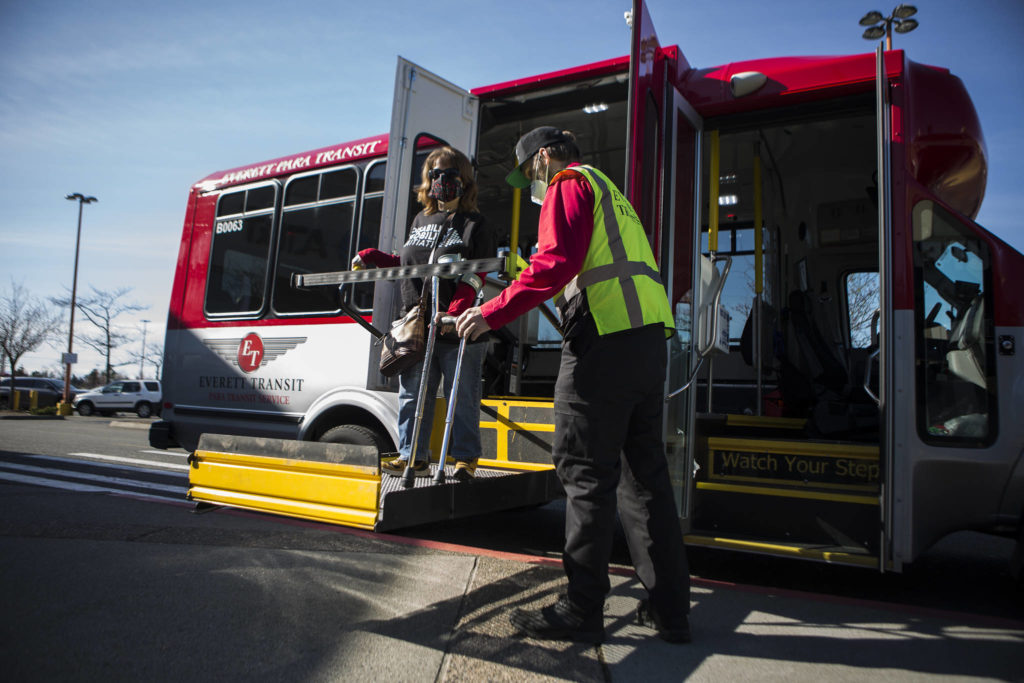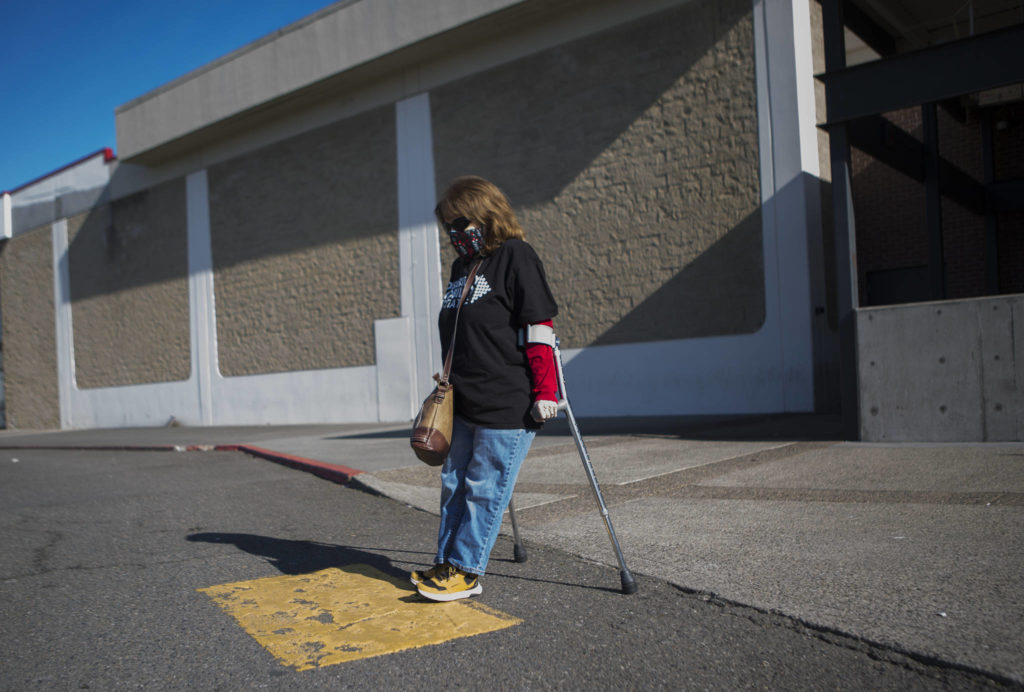Leigh Spruce asked a stranger to walk with her last year as she crossed the street in downtown Everett.
Spruce, 52, uses crutches, and crossing a road can make her anxious because she can’t dart away if a driver takes a corner without checking for pedestrians.
She was there for a jury duty summons. She used paratransit to travel from her home in Mill Creek.
Over the years, she has asked many people to keep pace with her through a crosswalk, hoping that there is greater visibility and safety in numbers.
“People kind of give me a funny look like, ‘But you can walk,’ ” Spruce said. “I walk slower than other people.”
Even at crosswalks with accessible curb ramps and pedestrian signals that flash or make noise, she fears not having enough time to cross safely. That’s just one issue she wants addressed in Everett’s Americans with Disabilities Act transition plan, a document about public right-of-way barriers and the priorities to address them.
The city is asking for input about those issues the rest of this month. People can participate online by calling 425-257-8821 to report a barrier or by mailing the ADA Compliance Team, City of Everett Public Works, 3200 Cedar Street, Everett, WA 98201.
In 1990, the Americans with Disabilities Act (ADA) was landmark federal civil rights legislation about government programs and property being accessible to people with disabilities. Over the decades since, the ADA has required cities, counties and states to ensure that public facilities such as crossings and sidewalks can be safely used by people with mobility needs.
An estimated 12.5% of Everett’s population under age 65 has a disability, according to U.S. Census data. The city used census tract data to evaluate areas of the city for the density of population with a disability, which is one of the factors weighed for ADA work. Disability advocates commonly say that most people will have a disability at some point in their life, which drives home the need to invest in accessible public transportation infrastructure.
Everett has worked on elements of a transition plan for almost a decade, first with a self-evaluation in 2011 and a draft right-of-way plan in 2018. The final version, which will become a “living document” and annually updated, is required in April.
“First and foremost, it’s the right thing to do,” said Everett transportation engineer Christina Anna Curtis.
For years the city’s public works department has evaluated a project area for accessibility needs. The Rucker Renewal project, for example, included the installation of accessible curb ramps along the corridor between Everett and Pacific avenues. That is standard procedure for all public works projects, principal engineer Tom Hood said.
But city crews can’t identify each and every inadequate curb ramp, non-compliant pedestrian cross signal or utility pole that blocks a sidewalk. City staff hope to learn which barrier locations are priorities for residents. Everett has an online interactive mapping tool at bit.ly/3qKH6NZ for people to pinpoint where barriers exist. The web page includes information on an online open house about the plan and what the city knows so far.
Everett’s website is friendly for people with low vision or a vision impairment, and it can be translated. An online open house fact sheet is available in Spanish, as well.
Everett Public Works has had a request form for accessibility work, though it can take years before the city is able to address some of those requests. After the department gets a request, someone from the streets division will go to the location and see what was reported. Then the ADA compliance team talks about what could and needs to be done.
“Whenever we get feedback (or) we get a request, our goal is to respond to them directly,” Curtis said.
This kind of work is critical for people with disabilities, Disability Mobility Initiative Director Anna Zivarts said. She has low vision and is a transit advocate because it’s critical for people who can’t operate a personal vehicle.
“There is a real gap in transportation for disabled folks,” she said.
The program she leads, which is part of the larger Disability Rights Washington organization, developed a story map of people with disabilities throughout the state talking about their challenges. Tasks like getting groceries, traveling to appointments and work, or just going out impulsively for a late-night snack require considerable forethought and coordination with paratransit or other public transit.
Transit access is a focus for Spruce, who is featured in the Disability Mobility Initiative’s story map. The issue could become more important as housing costs rise and push people farther from urban centers and frequent transit service.
“We need to have a bus route that goes out there because it’s further isolating the population,” she said. “It allows us with disabilities to be a part of our community and contribute to society.”
Money is the major constraint for accessibility infrastructure work. It could cost millions of dollars for Everett to address all of the right-of-way impediments along 313 miles of road and 343 miles of sidewalk.
Zivarts said funding is about priorities. For transportation infrastructure in Washington, that can mean a battle between highway and pedestrian improvements, she said.
Everett’s online open house at https://www.everettwa.gov/2664/ADA-Transition-Plan-Open-House about the ADA transition plan closes March 31. City staff are scheduled to present the information to the Everett Transportation Advisory Committee at 8 a.m. Thursday. People can join that meeting online or by calling 425-616-3920 with conference ID 990307783#.
Have a question? Call 425-339-3037 or email streetsmarts@heraldnet.com. Please include your first and last name and city of residence.
Talk to us
> Give us your news tips.
> Send us a letter to the editor.
> More Herald contact information.



























